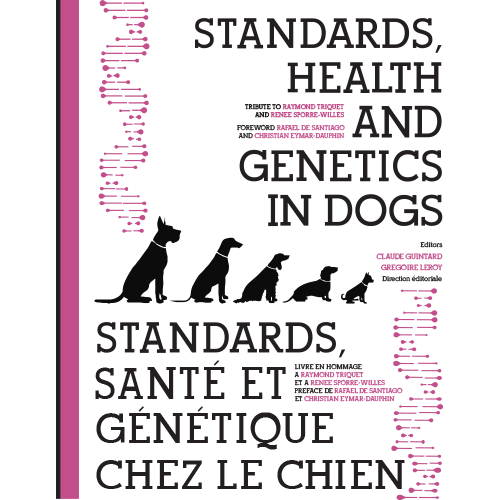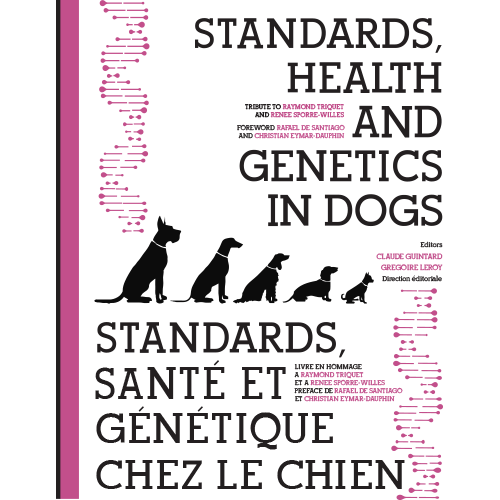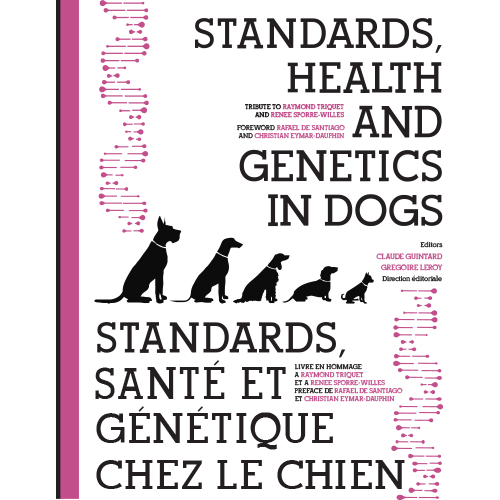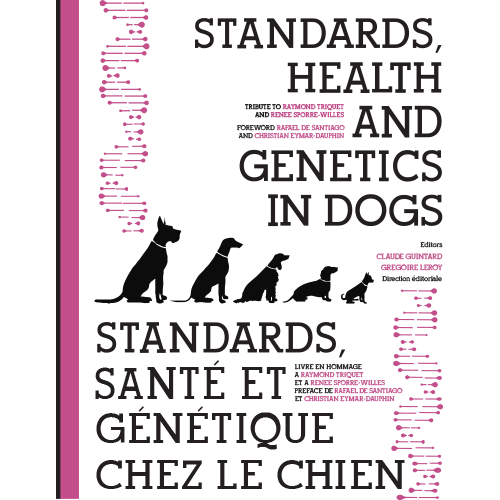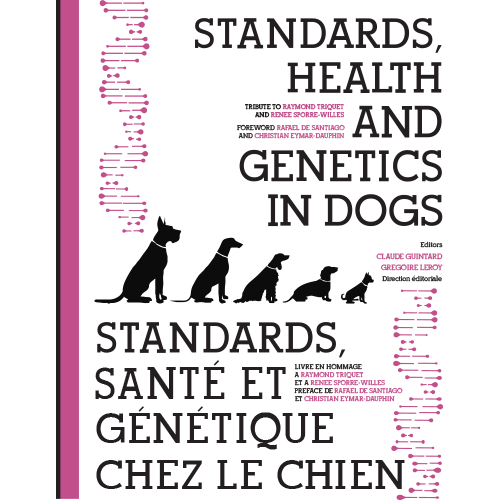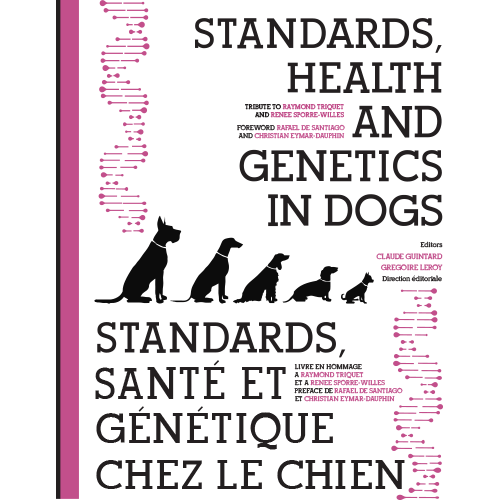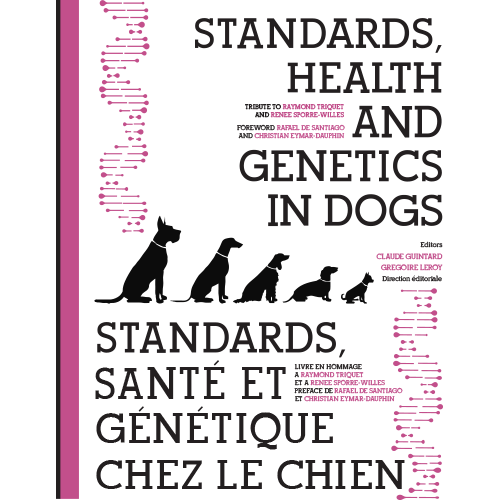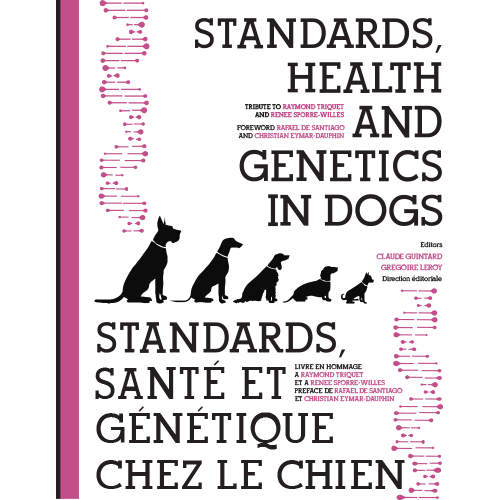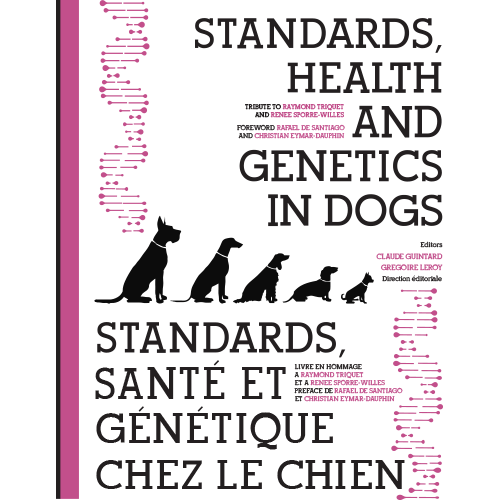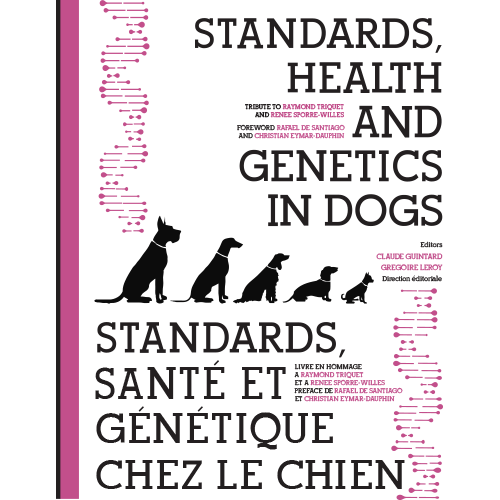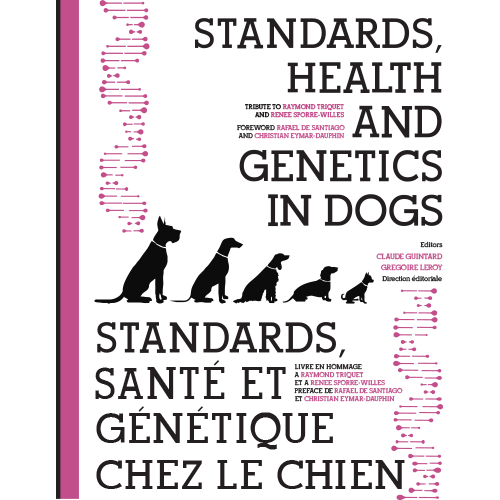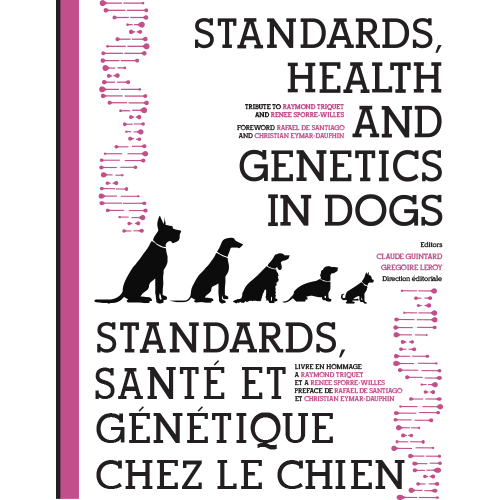Standards, Health and Genetics in Dogs
Book - Standards, Health and Genetics in Dogs/Standards, Santé et Génétique chez le Chien
GUINTARD C. and LEROY G. [Dir.], Standards, Health and Genetics in Dogs
/ Standards, santé et génétique chez le Chien /, FCI-SCC-SKK ed., 2017, ISBN : 9 782746 696730, 400 p.
Here you will find files that contain the Authors, Abstracts and other extracted information from articles contained in CHAPITRE I - LES STANDARDS / CHAPTER I - THE STANDARDS and CHAPITRE II - SANTÉ ET GÉNÉTIQUE / CHAPTER II - HEALTH AND GENETICS.
23 files
-
Table of Contents - Standards, Santé et Génétique chez le Chien-Standards, Health and Genetics in Dogs
Table of Contents...
GUINTARD C. et LEROY G. [Dir.], Standards, santé et génétique chez le Chien / Standards, Health and Genetics in Dogs, FCI-SCC-SKK éd., 2017, ISBN : 9 782746 696730, 400 p.
85 downloads
- genetics
- breed standards
- (and 1 more)
(0 reviews)0 comments
Updated
-
Standards, Health and Genetics in Dogs - Forwards - Rafael de Santiago and Christian Eymar-Dauphin
Rafael de Santiago, FCI President writes...
"Protecting and preserving dog breeds has been the Federation Cynologique Internationale’s most important aim and task for over 100 years... We are the people who have dedicated their lives to studying and analyzing dog breeds in order to ensure their functionality and health for generations to come..."
Christian Eymar-Dauphin, Président de la Société Centrale Canine (4 octobre 2011 au 3 janvier 2017) writes...
“Standards, Health and Genetics in Dogs” is a fact-filled, highly informative book that is being published on the occasion of the Third International Partnership for Dogs (IPFD) Workshop, to be held in Paris under the aegis of the Centrale Canine (French Kennel Club)... provides readers with a valuable knowledge base regarding the health and welfare of purebred dogs and, more generally, of all our companions who do not know how to ensure the flame of our shared passion never goes out."
51 downloads
(0 reviews)0 comments
Updated
-
Standards, Health and Genetics in Dogs - Introduction to Chapter I - Jorge Nallem
Full text in English...
Standards, Health and Genetics in Dogs - Introduction to Chapter I - The Standards
Jorge Nallem, President of the FCI Standards Commission since 2015, provides reflections on the nature and use of Breed Standards - their creation and impact on a breed's development/evolution and the important considerations for breeders and judges in interpretation of Breed Standards.
94 downloads
(0 reviews)0 comments
Updated
-
Standards, Health and Genetics in Dogs - Chapter 1- Origins of French dog standards, the 18th century stage-Pr. Raymond Triquet
Excerpts...
"For BUFFON, dogs "have par excellence all the interior qualities which can attract the regard of Man". This is indeed the basis of cynology in the purest sense of the word, the attraction which dogs hold for Man. As for the outside of the dog, it is clearly set out in the first sentence of the chapter: the size, the shape, the freedom of a dog’s movements are all dog-fanciers’ main concerns. The dog is unique as a species, but its shape, its temperament and its "natural talents" can vary considerably. There is a "variety of breeds which is so vast that we cannot even begin to count them". These differences can be noted concerning the "size, the figure (shape) of the body, the length of the muzzle, the shape of the head, the length and the dimension of the ears and the tail, the quality and the quantity of the hair", and the colour. All of this would be enough to enable the first standards to be set down.
"DAUBENTON (1716-1800 Louis Jean-Marie d'AUBENTON) worked in partnership with BUFFON and was destined to have a brilliant future. He would later be appointed to the chair of general zoology at the Collège de France. He set down the principle without which dog fancy would not exist: "several very distinct breeds" and one species. By crossing two breeds of dog together, he showed that it was possible to obtain a mongrel, and by crossing mongrels, that a "double mongrel" would be obtained until eventually a new breed would be produced. Little did he know that two centuries later, we would thus manage to obtain 350 breeds. As an anatomist, he specified that dogs, "all look the same on the inside concerning the soft parts" and differ regarding the skeleton ("by their bones") and the external shape of the body. In this way, the "distinct features of each breed" can be identified. This is the modern expression at the base of every classification, whether it be anatomical or linguistic."
80 downloads
- standards
- 18th century
- (and 4 more)
(0 reviews)0 comments
Updated
-
Standards, Health and Genetics in Dogs - Chapter 1- The work of the FCI to have breed standards recognized by all FCI members and their translations, by Yves De Clercq (Belgium)
Yves De Clercq, Executive director of the FCI, outlines the process used to create the F.C.I.'s Breed Standards in four languages. Translations to ensure accuracy of concepts ("realistic and easy-to-understand breed standards which meet with health and phenotypical requirements") presented in Breed Standards requires "an acute knowledge of canine and anatomical glossary and it can be very uneasy to translate some terms in a way which leaves no room to interpretation".
Full text of this important section of the book regarding the F.C.I.'s management of Breed Standards is presented in English.
67 downloads
(0 reviews)0 comments
Updated
-
Standards, Health and Genetics in Dogs - Chapter I - The bibliographies of Raymond Triquet and Renée Sporre-Willes (Presidents of the FCI Standards Commission [1999-2007 and 2007-2015]), by Dr. Claude Guintard (France)
Dr. Claude Guintard's section of the book contains references to the bodies of work of two successive generations of Presidents of the FCI Standards Commission between 1999 and 2015, Raymond Triquet (France) and Renée Sporre-Willes (Sweden). The references provided include books, publications, conference presentations and symposia – an exceptional piece of writing that reveals the vast knowledge of these individuals and their roles in shaping international cynology.
76 downloads
(0 reviews)0 comments
Updated
-
Standards, Health and Genetics in Dogs - Chapter 1- Focus on the current list of genes for coat colour and texture in dogs, by Pr. Bernard Denis (France)
Pr. Bernard Denis provides information on “modern” and “old” data for known coat colour genes/loci.
Pr. Denis provides a reference to an excellent online resource for coat color: http://www.doggenetics.co.uk.
Also see: F.C.I. Standardized Nomenclature of Coat Colours in dogs: B. Denis, Vienna, July 2009. English translation: http://www.fci.be/medias/SCI-REG-ROB-BDE-en-622.pdf
(Internal) STANDARDIZED NOMENCLATURE OF COAT COLOURS IN DOGS-Bernard Denis - FCI 2009.pdf
117 downloads
- coat color
- dogs
- (and 2 more)
(0 reviews)0 comments
Updated
-
Standards, Health and Genetics in Dogs - Chapter 1- The struggle against hypertypes: an old dog fancier’s point of view, by Pr. Raymond Triquet (France)
"PREAMBLE... This text has been published in French in three journals (Ethnozootechnie, Revue de la Cynophilie Française, and the Bulletin de la SADB); the originality of its presentation in this book does not therefore lie in a new version of the text in French, but in its distribution to a wider international audience through its English translation."
For the French version see - Ethnozootechnie n° 93 – 2012. pp 89-92.
LA LUTTE CONTRE LES HYPERTYPES, LE POINT DE VUE D'UN VIEUX CYNOPHILE -- Raymond TRIQUET (Internal link) _cle0fcd21-141.pdf Here you will find the full text of this section of the book in English. Pr. Triquet addresses hypertypes, matters of perception of beauty, dog showing and judging, the importance of Breed Standards and Club Newsletters in relating correct ideas about dogs qualities. The guiding statement made is that "beautiful dogs must also be happy dogs". Pr. Triquet concludes, "Purebred dogs, sometimes to their misfortune, are dependent on humans, and it is therefore down to mankind to demonstrate moderation in all things."
48 downloads
(0 reviews)0 comments
Updated
-
Standards, Health and Genetics in Dogs - Chapter 1- Standards, health and hypertypes in dogs-Pr. José Luis Payró Dueñas (Mexico
Pr. José Luis Payró Dueñas discusses brachycephalic traits at some length, and addresses morphological expressions that impact function.
Seeing to health and welfare of dogs is judges' and breeders' responsibility - correct construction and interpretation of breed standards is essential.
64 downloads
(0 reviews)0 comments
Updated
-
Standards, Health and Genetics in Dogs - Chapter 1- Genetics and standards in Dogs, by Pr. Jean-François Courreau (France)
Pr. Jean-François Courreau examines Breed Standards/breed descriptions in terms of their focus on describing morphology - visible traits. See a discussion of limitations of conformation ring evaluations to provide in-depth evaluation of abilities of breeds.
Excerpts...
"It is a paradox that the official classification of breeds recognised by the FCI is largely based on abilities, whereas the standards only really mention morphology..."
"A "beauty" show is rarely conducive to assessing abilities. Thus, for anything that is not morphological, assessments are very limited: the only behavioural element assessed is the ability to keep still before the judge and other dogs, and the only element of physical ability assessed is the quality of movement during a few laps of the ring. Finally, the situation of dog breeds at the beginning of organised breeding should be taken into consideration. It seems to us that for dog breeders 150 years ago, abilities were inextricably linked with the breed, and were even its very essence to those breeders. Thus, unable to imagine the loss of such qualities, these good dog lovers were mostly concerned with improving morphology, which was generally a weak point. Dogs that were "good" for a particular use could only remain so. Thus, as well as having "good" dogs, they would now also have "beautiful" dogs. A special tribute should therefore be paid to all dog breeders who have pursued selection based on ability, as well as to those who are currently setting up trials at all levels, in difficult conditions."
77 downloads
(0 reviews)0 comments
Updated
-
Standards, Health and Genetics in Dogs - Chapter 1- Two standards for one breed?, by Anne-Marie Class (France)
Anne-Marie Class elaborates on the breed standards offering an in depth analysis of the construct and development of F.C.I., British and AKC breed standards for the Mastiff and Golden Retriever.
Considering the fact that there are differences in the words used in written breed standards, Anne-Marie's examination of the the impact these differences in Breed Standards have on the look of these two breeds managed by Kennel and Breed Clubs operating on different continents provides food for thought.
"This essay is an opportunity to reflect on standards, on their possible and desirable variability and on the necessity for these standards to give precise details."
Abstract - The basic question is, "what is a standard?"
89 downloads
- golden retriever
- mastiff
- (and 2 more)
(0 reviews)0 comments
Updated
-
Standards, Health and Genetics in Dogs - Chapter I - Gait, movement and related characters in various selected breed standards - Martin S. Fischer (Germany)
For a write-up on The Jena Study referenced in Pr. Fischer's section of this book see:
https://www.uni-jena.de/en/News/Archiv/Archiv+2011/PM110527_Hundestudie_en.html
For further information available on the VDH's website see "Dogs in Motion" :
https://www.vdh.de/en/shop/dogs-in-motion/
58 downloads
(0 reviews)0 comments
Updated
-
Standards, Health and Genetics in Dogs - Chapter 1 - The Standards Thoughts on the description of ears in FCI dog breed standards, in the Head paragraph entitled "Facial region" Raymond Triquet and Claude Guintard (France)
Abstract - In question and answer form, the authors reflect on the origin of the description of ears in official dog breed standards, in the “Facial region” section. Anatomically, the base of the ear is the temporal bone, and ears are therefore an integral part of the cranial region (and under no circumstances of an animal’s facial region). It therefore seems paradoxical that this heading appears in the facial region section in the FCI model standard. After taking a historical look at the possible origin of this anomaly, the authors propose a change that would be very easy to accomplish, by altering the typography and format of dog breed standards.
This article includes a: QUESTION FROM CLAUDE GUINTARD TO RAYMOND TRIQUET (FORMER PRESIDENT OF THE FCI STANDARDS COMMISSION), THE “FATHER” OF THE FCI BREEDS NOMENCLATURE and the ANSWER FROM RAYMOND TRIQUET TO CLAUDE GUINTARD (MEMBER OF THE FCI STANDARDS COMMISSION) IN THE FORM OF A SHORT HISTORICAL SUMMARY.
85 downloads
- ears
- standard schnauzer
- (and 2 more)
(0 reviews)0 comments
Updated
-
Standards, Health and Genetics in Dogs - Chapter II - Health and genetics - Foreword by the president of the FCI scientific commission Kirsi Sainio (Finland)
By Kirsi Sainio
66 downloads
(0 reviews)0 comments
Updated
-
Standards, Health and Genetics in Dogs - Chapter II - The notion of breed, by Pr. Zeev Trainin (Israel)
Pr. Zeev Trainin discusses the domestication of dogs and breed formation/development since the mid-19th century involving Breed Standards and dog shows.
"To develop the show type, selection became focused on aesthetics through often excessive inbreeding, with little attention to long-term consequences, resulting occasionally in health impairments and genetic disorders."
"To acknowledge a problem is half the way toward solving it. Select against genetic disorders, increasing the breeding stock, and in specific cases using crossing between varieties, constitute options that may lead to the improvement of the situation. With the new tool of advanced molecular genetics, breeders have a golden opportunity to produce healthy, well-shaped dogs capable of functioning for the benefit of dog and man."
109 downloads
- genetic disorders
- functionality
- (and 6 more)
(0 reviews)0 comments
Updated
-
Standards, Health and Genetics in Dogs - Chapter II - Relationships between genetics, breeding practices and health in dogs - Grégoire Leroy (France)
By Gleroy
Abstract - In this chapter, we examine the specificities of dog breeding and selection in order to better understand how these practices impact breed health. Selection within the species is characterised by breeding in closed populations, selection objectives that are generally aimed at conformation, animals that receive substantial veterinary care, selection that is often empirical using a small number of breeding dogs and, more occasionally, the use of practices such as mating between close relatives.
These practices can have different direct or indirect consequences on breed health. We address in particular the potential health impacts of selection based on morphology (hypertypes, etc.), as well as genetic drift, linked to a limited basis of selection, resulting in particular in an increase in inherited diseases. Faced with these recurrent problems, it is important that clubs and breeders hoping to improve their breed health adapt their practices and use the appropriate tools, especially in terms of breeding strategies and diagnoses.
73 downloads
- breeding
- inbreeding
- (and 4 more)
(0 reviews)0 comments
Updated
-
Standards, Health and Genetics in Dogs - Chapter II - Elbow dysplasia - Margarita Durán (Uruguay)
Abstract - Elbow dysplasia (ED) is a multifactorial disease that appears early in life and affects mainly medium and large dogs causing limitation in movement and gait due to alterations at the level of the joint surfaces.
Under the name of ED four diseases are grouped: ununited anconeal process (UAP), osteochondrosis (OC), fracture of the medial coronoid process (FMC) and incongruity (INC).
These different pathologies produce cartilage wear that inevitably will manifest as arthrosis.
Alterations in skeletal development and biomechanical changes, trauma, imbalanced diets or excess food act unfavourably and may be responsible for some of the forms of elbow dysplasia.
The radiological diagnosis of elbow dysplasia is difficult due to the overlap of the bony parts and the possible simultaneous presence of different pathologies in the same joint.
The International Elbow Working Group based the diagnosis on the presence of primary lesions and / or osteoarthrosis.
63 downloads
- treatment
- multifactoral
- (and 4 more)
(0 reviews)0 comments
Updated
-
Standards, Health and Genetics in Dogs - Chapter II - From classical genetics to molecular genetics - Catherine André and Bernard Denis (France)
Abstract - Spectacular advances in molecular genetics are gradually being implemented in practical applications, but they must be better understood if they are to be put to good use. In this respect national kennel clubs have a key role to play between the worlds of research, veterinary medicine and breeding. However, effective breeding has been possible using data from classical genetics, which are briefly described in four areas: morphological characteristics – which are of such importance in dogs because selection based on “beauty” is still predominant –, coat colour and hair structure, behavioural traits and, finally, inherited diseases. It is especially in the field of genetic diseases that classical knowledge about heredity has been shown to be insufficient in terms of the applications expected, the “weak point” being the inability to objectively identify asymptomatic carriers. Molecular genetics has come a long way since the first gene maps, producing fundamental knowledge about the location, then the function, regulation and expression of genes, as well as providing breeders with genetic tests that can be used to identify dogs, detect disease carriers, assist in disease diagnosis and predict the genetic status of a litter. Knowledge gained about the canine genome is described, as well as the genetic studies enabled by the development of DNA microarrays: determining the genetic profile unique to each individual, detecting single-nucleotide polymorphisms, etc. More and more is known about the genetic basis of diseases through the understanding of gene regulation mechanisms and the influence of environmental factors on gene expression in the context of epigenetics. The following section recalls the extraordinary phenotypic diversity observed across all dog breeds, arising mainly from human selection. This has proved very effective, but it has also gone hand in hand with the inadvertent co-selection of alleles responsible for diseases. The authors illustrate this process, taking several examples from the four areas chosen in order to present data from classical genetics. At the same time, basic knowledge about the genes concerned is also presented. Research on inherited diseases is all the more important in that it benefits both human and veterinary medicine. The biobank of samples from dogs of all breeds, whether affected by a given genetic disease or healthy, which was created and is managed by the CNRS team in Rennes, plays a key role in the research system. The article ends with the issue of genetic testing aimed at detecting carriers, which is attracting considerable interest from breeders. In conclusion, the authors reiterate the importance of successful collaboration between researchers, veterinarians and breeders, and underline the fact that that seminars on “Genetics and health”, such as the one to be held in April 2017, are a concrete example of this.
55 downloads
(0 reviews)0 comments
Updated
-
Standards, Health and Genetics in Dogs - Chapter II - Genetic testing in dogs - Marie Abitbol (France)
Abstract - Over the past 15 years, the advent of powerful tools for exploring the canine genome has led to the discovery of a growing number of genes and mutations involved in canine diseases or traits of interest. To date, more than 670 canine inherited traits have been identified, more than 200 of which have been elucidated at the molecular level (gene and mutation identified). These mutation discoveries result in screening and diagnostic DNA tests for inherited diseases, but also in DNA tests for desirable traits such as coat colour or texture. In order to put these tests to good use, it is essential to understand the specificities of canine and feline inherited diseases, which determine the fields of application for these tests and the interpretation of their results.
The first part of this chapter presents the genetic characteristics of the canine species and the basics of canine genetics. The second part addresses the use of screening and diagnostic tests for inherited diseases, with a focus on genetic counselling and the parameters that determine the interpretation of test results. The third part concentrates on the search for informations on canine inherited diseases and the tests available. The final part presents tests for aesthetic characteristics such as coat colour.
89 downloads
(0 reviews)0 comments
Updated
-
Standards, Health and Genetics in Dogs - Chapter II - Activities by FCI and others to handle an increased risk of inherited disorders in pedigree dogs (PDGD): Past, present and future - Åke A. Hedhammar (Sweden)
Abstract
Over the comparably short period of kennel clubs- in the span of man’s life with dogs - several activities have been instituted in the past to influence health and well being in so called “pure bred” or “pedigree dogs” Presently many more activities are in focus. As one of the stakeholders FCI have been involved in many of these activities and is urged to take an active part in further efforts to reduce the prevalence of inherited disorders in pedigree dogs.
The term pedigree dogs (PDGD) have been used and will in the following be used for Dogs with known pedigree and resulting most commonly from mating of dogs within the same breed.
Together with other stakeholders FCI and Kennel Clubs worldwide share a responsibility not only for health and well being of the dogs they register. By setting “standards” they indirectly also have an influence on the public perception of any dog claimed to be of a certain breed.
In this paper past and present activities will be reviewed. Proposed further and future activities to handle an increased risk of inherited disorders in pedigree dogs will be suggested.
108 downloads
- pedigreed dogs
- breeding
- (and 2 more)
(0 reviews)0 comments
Updated
-
Standards, Health and Genetics in Dogs - Chapter II - Canine ophthalmology and genetics in dogs - Gilles Chaudieu (France)
Abstract - Progressive selection has associated ocular conformation with breed morphotype. Some ocular lesions are linked to general morphological traits, whether normal or exaggerated.
The appearance of a mutation responsible for a monogenic inherited eye disease (IED) in a breed is called the founder effect, and may be ancient or recent. Most IEDs are passed on as simple autosomal recessive traits. Clinical diagnosis and knowledge of genealogy are required to suspect and confirm an ocular disease as an IED. Genetic testing must be used as a very informative complementary examination, which requires specific indications and has some limitations.
84 downloads
(0 reviews)0 comments
Updated
-
Standards, Health and Genetics in Dogs - Chapter II - The importance of dogs for comparative pathology and genetics: examples of shared resources and programmes - Catherine André1, Éric Guaguère2, Gilles Chaudieu3, Jean-Pierre Genevois4 et Patrick Devauch
Abstract - As part of this tribute to Raymond Triquet and Renée Sporre-Willes on the occasion of the 3rd International Dog Health Workshop, we thought it important to demonstrate the need for collaboration between disciplines: between veterinarians, researchers, doctors, breeders and dog fanciers, in the interest of dogs to ensure better health and better genetic management of breeds in a context in which the emerging genetic tests may prove very useful, but must be used wisely.
Working in close collaboration for many years between the CNRS genetic research team in Rennes and Doctors Gilles Chaudieu, Éric Guaguère, Jean-Pierre Genevois and Patrick Devauchelle, in this chapter we propose a focus on the state of knowledge and on certain projects led by the Rennes lab in ophthalmology, dermatology, orthopaedics and oncology.
In dogs, the quest for conformation with the breed standard has resulted in the selection of specific alleles to meet the desired criteria (different aptitudes, morphological and physiological traits). Indeed, dogs, with more than 400 breeds, represent genetic isolates within which individuals belonging to the same breed share the same phenotype and almost the same genotype in order to meet the desired criteria. Unfortunately, this selection has also resulted in the concentration of deleterious alleles, causing genetic diseases in many dog breeds.
We will therefore stress the importance of exchange, collaboration, comparison and complementary expertise, in order to use the resources and the genetic methods now available to us, with mutual understanding between actors in veterinary medicine, dog breeding and research. Moreover, we will use selected examples to demonstrate the importance of comparative pathology and genetics in dogs for veterinary and human medicine in order to identify the genetic causes of homologous diseases between humans and dogs, and to eventually improve the screening and treatment of these diseases in the dogs and their owners.
Findings in recent years, whether by international research teams or the team in Rennes, have revealed: 1/ the importance of collaboration between researchers, veterinarians, breeders and breed clubs; 2/ the need to rely on several medical/veterinary disciplines, such as epidemiology, histology, imaging, genetics, etc, which have made huge progress and are giving the “One Health” concept its full meaning; and 3/ the urgent need for international kennel clubs to adopt in order to integrate all of this data for the benefit of dogs into the various facets of their activities.
We will discuss:
1 - Dog breeds, genetic selection, genetic diseases;
2 - The importance of collaboration and shared interfaces and resources;
3 - Four examples of canine and human diseases illustrating the “One Health” concept.
147 downloads
(0 reviews)0 comments
Updated
-
Standards, Health and Genetics in Dogs - Conclusion
"At the end of this book, the reader will be aware of the research underway on standards and their importance in the world of dog breeding, but also on genetic diseases and health in dogs..."
This document is available in English and French.
91 downloads
(0 reviews)0 comments
Submitted
 Donate
Donate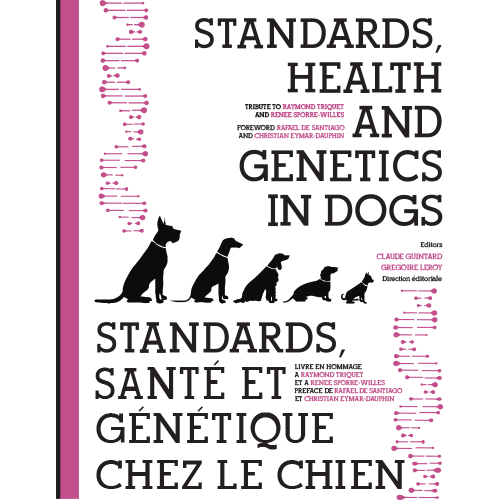
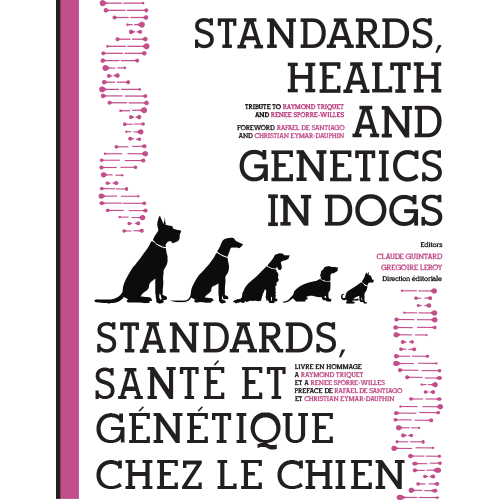
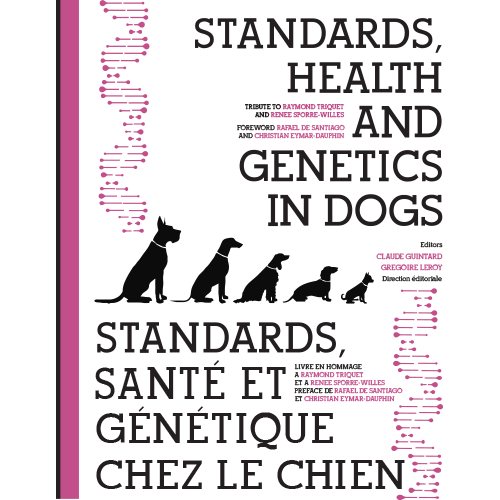


![More information about "Standards, Health and Genetics in Dogs - Chapter I - The bibliographies of Raymond Triquet and Renée Sporre-Willes (Presidents of the FCI Standards Commission [1999-2007 and 2007-2015]), by Dr. Claude Guintard (France)"](https://dogwellnet.com/uploads/monthly_2018_06/1808900894_book-covervector6-3-18.thumb.png.62a5b28ef65518fdba44d40085dc59ed.png)
